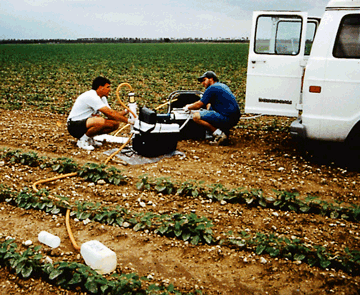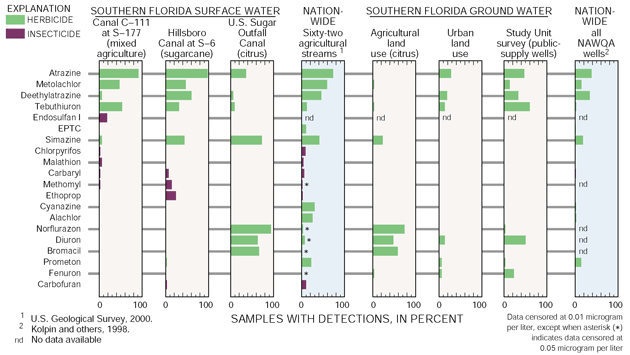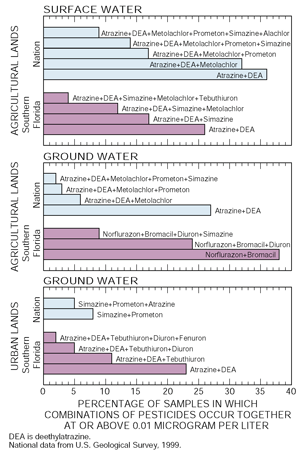MAJOR FINDINGS
Nutrient enrichment is prevalent in surface water
Water quality has been degraded in large parts of southern Florida by human activities that result in high nutrient concentrations and over-enrichment. Nutrient concentrations at the SOFL NAWQA sites are elevated when compared with Everglades background concentrations (see box below). The high nutrient concentrations, primarily from agricultural runoff, have contributed to overenrichment of surface water, including Lake Okeechobee, estuaries such as Charlotte Harbor, and the northern Everglades. The high phosphorus concentrations in agricultural runoff entering the northern Everglades are a significant cause of ecosystem degradation.
The USEPA recently (May 26, 1999) approved a new water-quality standard of 0.01 mg/L or less for phosphorus in the Miccosukee Federal Indian reservation lands of the Everglades. The State of Florida is reviewing additional scientific information and plans to adopt a numerical phosphorus standard for other parts of the Everglades.
|
Concentrations of nutrients in surface water at the SOFL sites vary widely compared with national NAWQA median concentrations. Generally, the high nutrient concentrations in southern Florida are at canal and river sites north of the Tamiami Trail and are associated with agricultural activities. Concentrations of phosphorus in surface water of the more pristine Everglades (south of the Tamiami Trail) are more than an order of magnitude lower than national background concentrations. The Everglades ecosystem is adapted to water that has extremely low hosphorus concentrations and is being adversely affected by agricultural runoff with high concentrations of phosphorus. Concentrations of phosphorus in southern Florida are highest in the Peace River (fig. 4) and are well above national median concentrations. The high concentrations in the Peace River are associated with natural sources (phosphatic deposits) as well as mining and agricultural activities in the basin. Concentrations of nutrients in shallow ground water at SOFL wells generally are lower than or comparable with the national background concentrations. Median concentrations of nitrate in the southern Florida wells are one-fourth the national background concentration, and median concentrations of orthophosphate are comparable to the national background concentration. Concentrations of nutrients at the SOFL sites are plotted against corresponding national nutrient ranges for different land uses in Appendix A.
|
|||||||||||||||||||||||||||||||||||||||||||||||||||||||
All routinely sampled SOFL sites (BFS sites, see Glossary) had phosphorus concentrations that exceeded the USEPA Everglades standard of 0.01 mg/L, but the two southern sites, Canal C-111 and Tamiami Canal at bridge 105, had median concentrations near the 0.01-mg/L Everglades standard (fig. 4). The ENP reference sites had median phosphorus concentrations below 0.01 mg/L and are characteristic of pristine Everglades water.
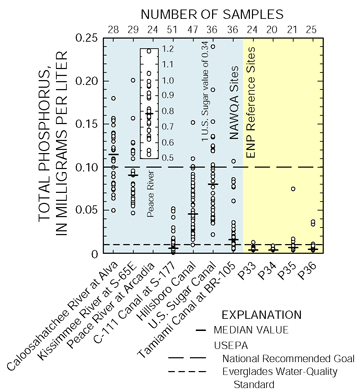 |
| Figure 4. Concentrations of total phosphorus (TP) at SOFL NAWQA sites during 1996–98 frequently exceeded the USEPA recommended goal of 0.1 mg/L and Everglades standard of 0.01 mg/L. Concentrations of TP at Everglades National Park reference sites were near or below 0.01 mg/L. |
|
| Ground-water sampling, eastern Everglades C-111 agricultural basin. |
Seasonal changes in total phosphorus concentrations often are related to changes in water levels and flows. Generally, concentrations were below 0.02 milligram per liter (mg/L) at the Big Cypress Swamp reference site (Br 105) during 1996–98, but increased to more than 0.10 mg/L as water flows and levels declined during the dry season (fig. 5). The increase in phosphorus concentrations occurs when fish, wading birds, and other aquatic organisms congregate in ponded waters and their wastes contribute nutrients to the remaining inundated areas. The relatively greater ground-water contributions to surface water during the dry season also may increase nutrient concentrations. The background marsh sites in the ENP had very low concentrations of phosphorus (less than 0.01 mg/L) throughout the 1996–98 sampling period, and effects of seasonal low water levels on nutrients were not evident.
 |
|
| Figure 5. Total phosphorus concentrations increased as discharge and water levels declined at Tamiami Canal at Bridge 105, Big Cypress National Preserve. |
The dominant source of phosphorus loading in southern Florida is fertilizer (fig. 6). Manure and atmospheric sources are also important in some subbasins. Annual phosphorus loads estimated for selected canals and rivers were highest in the Peace River and lowest in the eastern Big Cypress Swamp. Much more phosphorus has been transported seaward from the northern Everglades and Okeechobee basins by the Caloosahatchee River, St. Lucie Canal, and major canals of Palm Beach County than is transported seaward in the southern Everglades (Haag and others, 1996).
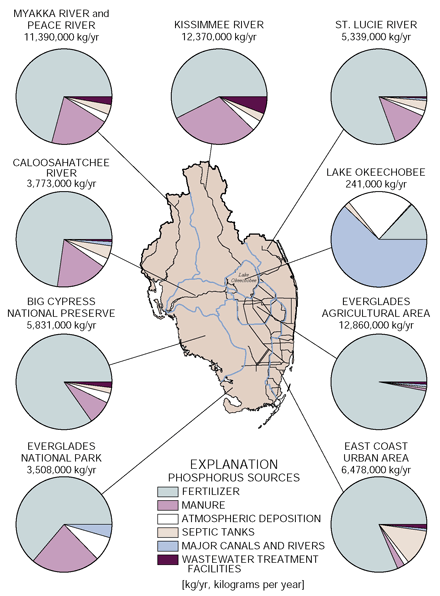 |
| Figure 6. Estimated phosphorus loading from point and nonpoint sources in surface-water basins in southern Florida (Haag and others, 1996). |
Nutrient concentrations in ground water are highly variable
High nitrate concentrations (greater than 10 mg/L) in drinking water can cause a life-threatening illness in infants known as “blue-baby syndrome.” Nitrate concentrations in ground water were low (commonly not detected) in most of the 108 wells sampled in the SOFL Study Unit, but a few occasionally were elevated in areas with agricultural land use. Wells located in or near the mixed-agricultural land-use area (including public-supply wells) tended to yield water with detectable concentrations of nitrate, but no nitrate concentrations exceeded the drinking-water standard of 10 mg/L. More than half of the wells located in citrus groves yielded water with no detectable nitrate concentrations, but two wells had nitrate concentrations above the drinking-water standard. With a few exceptions, shallow Biscayne aquifer wells in the urban land-use area contained water with relatively low concentrations of nitrate.
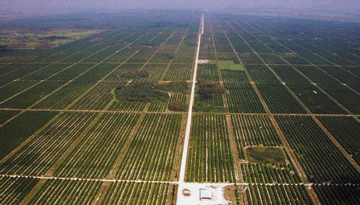 |
| Citrus groves north of Big Cypress Swamp. |
Ammonia concentrations in ground water in the SOFL Study Unit were relatively high compared with concentrations in other NAWQA Study Units across the Nation. The median ammonia concentration (0.396 mg/L) in the SOFL citrus land-use survey was the highest of 47 NAWQA agricultural surveys nationwide. Median concentrations of ammonia in the SOFL urban and study-unit survey (public water supply) ranked second and fifth highest, respectively, in these categories nationally.
Dissolved phosphorus concentrations in SOFL wells ranged from 0.001 to 0.79 mg/L; most land-use areas had median concentrations less than 0.01 mg/L (table 1). Concentrations above 0.05 mg/L occurred in some wells in all land-use and public-supply surveys, but highest concentrations generally were in the deeper public-supply wells of the Biscayne aquifer and in the citrus land-use area. The source of the relatively high concentrations of phosphorus in ground water may be fertilizers or naturally occurring phosphatic materials associated with silt and clays.
| Table 1. Dissolved phosphorus concentrations varied widely in shallow wells in southern Florida during 1997-98. (Different detection levels were reported for different survey types during the period) [B, Biscayne aquifer; S, unnamed surficial aquifer; <, less than] |
|||
| Survey type |
Number of wells and samples |
Range, mg/L |
Median mg/L |
|---|---|---|---|
| Urban/residential (B) |
32 |
<0.01-0.30 |
<0.01 |
| Urban background (B) |
3 |
<0.01-0.07 |
<0.01 |
| Citrus (S) |
31 |
<0.01-0.79 |
0.023 |
| Citrus background (S) |
5 |
<0.004-0.036 |
<0.01 |
| Mixed
agricultural |
7 |
0.001-0.019 |
0.003 |
| Public supply (B) |
30 |
<0.01-0.34 |
<0.01 |
Dissolved organic carbon concentrations are commonly high
Dissolved organic carbon (DOC) originates from natural sources, such as living and decaying plants, and from human sources. DOC represents about half the dissolved organic matter (DOM) in natural waters (Hem, 1985). In southern Florida, DOC concentrations commonly are high compared with other natural waters in the Nation and may constitute, as DOM, a significant fraction of the dissolved solids (table 2).
Concentrations of DOC ranged from 4.8 to 52.0 mg/L at the SOFL surface-water sites, and from 0.6 to 80 mg/L at the ground-water sites (table 2). The highest DOC concentrations (median of 34.0 mg/L) occurred at Hillsboro Canal at S-6 in the northern Everglades downgradient from the Everglades Agricultural Area, which has highly organic muck soils that are thought to be a source of DOC. In contrast, the Big Cypress Swamp reference site at Tamiami Trail Bridge 105 had the lowest concentrations (median of 9.5 mg/L) of the routinely sampled sites. This site is characterized by natural swamp vegetation and thin carbonate soils and rock. Concentrations of DOC at sites along the Tamiami Trail (1996–97) ranged from 4.8 to 26.9 mg/L (table 2), and tended to be low in the central and eastern Big Cypress Swamp and higher in the western Big Cypress and to the east in the Everglades (Miller and others, 1999).
| Table 2. Concentrations of dissolved organic carbon, in milligrams per liter, at surface- and ground-water sites in southern Florida, 1996-98 [Dissolved organic carbon (DOC) in natural water typically is 45 to 55 percent of the dissolved organic matter (DOM; Robert Wershaw and Jerry Leenheer, oral commun., 1997) and averages about 50 percent of the DOM that also includes other elements such as oxygen, hydrogen, nitrogen, phosphorus; --, no data] |
||||
| Sampling site |
Range |
Median |
Number of DOC samples |
DOM as a |
|---|---|---|---|---|
| Surface Water |
||||
| Kissimmee River at S-65E |
13.0-22.0 |
16.0 |
29 |
20-39 |
| Peace River Arcadia |
8.6-26.0 |
15.0 |
30 |
6-36 |
| Caloosahatchee River at Alva |
13.0-22.0 |
16.0 |
27 |
5-15 |
| Hillsboro Canal at S-6 |
15.0-52.0 |
34.0 |
48 |
7-13 |
| U.S. Sugar |
17.0-30.0 |
20.0 |
37 |
11-16 |
| Tamiami Canal at Bridge 105 |
7.1-14.0 |
9.5 |
35 |
5-18 |
| Canal C-111 at S-177 |
5.0-18.0 |
6.6 |
51 |
4-9 |
| All 7 Basic Fixed Sites |
5.0-52.0 |
16.0 |
257 |
4-39 |
| Tamiami
Trail, SOFL data |
4.8-26.9 |
12.5 |
43 |
-- |
| Ground Water |
||||
| Urban/residential land-use wells |
1.9-36 |
11.5 |
32 |
-- |
| Citrus wells |
2.7-80 |
24 |
29 |
-- |
| Public-supply wells |
0.6-22 |
9.4 |
30 |
-- |
The amount of DOC in water is significant. It can (1) contribute to water color, which absorbs sunlight and reduces the amount of light available for use by submerged aquatic plants and phytoplankton; (2) serve as a source of carbon for bacterial growth; (3) form complexes with trace elements, such as mercury, and make them more soluble and mobile in water (Reddy and others, 1999); (4) reduce bioavailability of nonionic organic compounds through sorption, entrapment, or sequestering the compounds (Nowell and others, 1999, p. 296); (5) increase the solubilities of relatively insoluble compounds, such as p,p'-DDT, PCBs, and lindane (Chiou and others, 1986); and (6) react with chemicals used to disinfect public water supplies and produce undesirable by-products, such as chloroform and other trihalomethanes, that may have harmful effects on human health.
Naturally occurring dissolved organic matter (DOM) causes the tea-colored water in many of Florida’s rivers and swamps. Water color can have significant ecological effects by decreasing available light in the water column and reducing algal and aquatic plant productivity and growth. In the Peace River and upper Charlotte Harbor, for example, color can contribute up to about half of the total light attenuation in the water column, and this high attenuation limits algal phytoplankton and seagrass growth (McPherson and Miller, 1987). The range in color for southern Florida water, including the NAWQA sites, is shown in table 3.
| Table 3. Water color for southern Florida surface-water sites, 1913-1999 (Color is reported in platinum-cobalt units. Data from U.S. Geological Survey data bases) |
||||
| Sampling site |
Range |
Median |
Number |
Period of record |
|---|---|---|---|---|
| Kissimmee River, S-65E |
25-240 |
85 |
51 |
1959-75 |
| Peace River, Arcadia |
0-320 |
82.5 |
414 |
1930-99 |
| Caloosahatchee River at S-79 |
5-500 |
62.5 |
144 |
1953-88 |
| Hillsboro Canal at S-6 |
30-560 |
120 |
89 |
1945-84 |
| Tamiami Canal at Bridge 105 |
10-100 |
30 |
56 |
1967-99 |
| Canal, C-111 at S-18-C |
0-40 |
5 |
40 |
1970-83 |
| Everglades P-33 |
10-120 |
45 |
82 |
1959-85 |
| 878
southern Florida sites in Miami |
0-640 |
55 |
11,457 |
1913-99 |
Pesticides are present in most surface-water samples
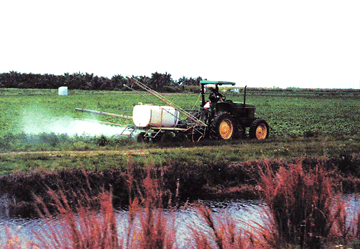 |
|
| Pesticide application in vegetable farming area. |
Pesticides are widely used in southern Florida to control insects, fungi, weeds, and other undesirable organisms. These compounds vary in their toxicity, persistence, and transport. Some of the more persistent pesticides, such as DDT, chlordane, dieldrin, and aldrin, have been discontinued for use in Florida, but their residues persist in the environment. Although pesticides usually are applied to specific areas and directed at specific organisms, these compounds often become widely distributed and pose potential hazards to nontarget organisms.
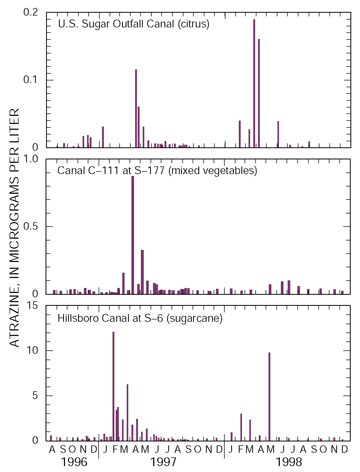 |
| Figure 7. Concentrations of atrazine at the Intensive Fixed Sites, August 1996–December 1998, showing similar seasonal occurrence patterns but different concentrations. |
Intensive pesticide sampling (up to weekly sampling) was conducted at three SOFL sites (IFS sites, see Glossary) that represented three different agricultural land uses — mixed vegetable crops (C-111 basin), sugarcane (S-6), and citrus (U.S. Sugar). Pesticides were detected in all but one sample from the three intensive-sampling sites during 1996–98. The most frequently detected pesticides included those with highest annual application rates, such as the herbicides atrazine, bromacil, simazine, 2-4-D, and diuron. Atrazine, the most frequently detected pesticide overall, was detected in about 90 percent of all samples. The other most frequently detected pesticides overall were metachlor, simazine, tebuthiuron, norflurazon, bromacil, and diuron.
Concentrations of pesticides in water were seasonal and related to land use. Concentrations of atrazine peaked at all three sites in late winter and spring (fig. 7). Concentrations were highest at the S-6 site, where some samples had atrazine concentrations that exceeded the Canadian aquatic-life criterion of 2 µg/L and the USEPA MCL of 3 µg/L. Concentrations at the other two sites were significantly lower, with maximum values less than 1 µg/L.
A pesticide of particular concern, endosulfan, was detected mainly at the Canal C-111 site (fig. 8). Endosulfan was detected by the South Florida Water Management District (SFWMD) over a number of years in the C-111 basin at levels considered to be a threat to aquatic life in the basin and in nearby Florida Bay (Miles and Pfeuffer, 1997). During the intensive sampling period of the SOFL study (1996–98), endosulfan concentrations were 0.05 µg/L or less (fig. 8), which is just below the Florida Department of Environmental Protection criterion (0.056 mg/L) for Class III (recreation, propagation and maintenance of a healthy, well-balanced population of fish and wildlife) freshwater. Detections of endosulfan were frequent in 1996 but became less frequent in the following 2 years, as the use of this pesticide was discouraged and an alternate, imidacloprid, was introduced.
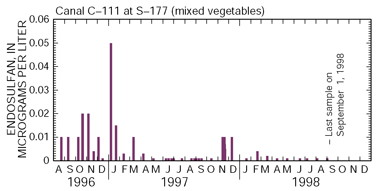 |
|
| Figure 8. Concentrations of endosulfan at Canal C-111 at S-177, August 1996-September 1998. |
Mixtures of pesticides were common in samples from SOFL and other national NAWQA sites (see figure on page 13). The effects of pesticide mixtures on biota or humans are not included in criteria, which are based on the results of single-species, single-chemical toxicity tests conducted in the laboratory. As a result, analyses of individual pesticides may under-estimate potential adverse effects of contaminants on biota (Nowell and others, 1999).
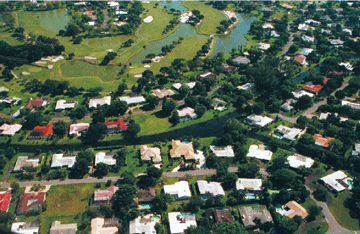 |
| Residential land near Fort Lauderdale. |
The NAWQA Program uses Federal drinking-water standards and guidelines to assess the quality of drinking water in potential surface- or ground-water sources prior to treatment and distribution. This complements many ongoing Federal, State, and local monitoring programs that assess drinking water after treatment and distribution.
Different patterns of pesticide detections were evident in surface and ground water of the different land-use areas of southern Florida. For example, norflurazon and bromacil frequently were detected in citrus land-use areas but seldom detected in other agricultural and urban areas. Detections of prometon and fenuron were relatively high in the public-supply wells of the Biscayne aquifer but were much lower in other areas. Many of the same pesticides were detected in surface and ground water nationwide, but a few such as alachlor, cyanazine, and carbofuran were mostly absent in southern Florida. The most commonly detected pesticides, such as atrazine, simazine, and metolachlor, were more common in surface water than in ground water in both southern Florida and the Nation. Concentrations of selected herbicides at SOFL sites are plotted against corresponding national herbicide ranges for different land uses in Appendix A. |
Regional patterns of pesticides, VOCs, and trace elements are evident in ground water
Pesticides were detected in ground water from more than 85 percent of the 108 SOFL wells and beneath every type of land use studied. No pesticide concentration exceeded USEPA or State of Florida drinking-water standards or health advisories.
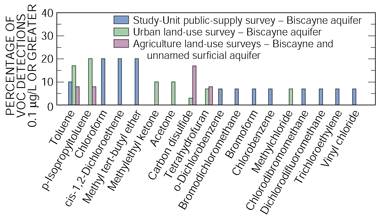 |
| Figure 9. Percentages of common volatile organic carbons (VOCs) detected in water from shallow urban (residential) and agricultural wells and from deeper public-supply wells (see Study Unit Design on page 22 for locations). |
VOCs commonly were detected in water from shallow, residential land-use wells and deeper publicsupply (study-unit survey) wells in the Biscayne aquifer (fig. 9). Vinyl chloride, trichloroethylene, tetra-chloroethylene, cis-1,2-dichloro-ethene, and methyl tert-butyl ether (MTBE) were detected more commonly in the older residential and industrial areas and in public-supply wells near mixed agricultural lands. Toluene, p-isopropyltoluene, and 1,2,4-trimethyl-benzene commonly were detected in the newer residential areas and in public-supply wells near mixed agricultural lands. Two samples from public-supply wells in more industrialized areas had vinyl chloride concentrations (4.68 and 3.18 µg/L) slightly above the USEPA MCL of 2 µg/L.
Urban and agricultural activities are sources of trace-element contamination in ground water. Arsenic and copper are used as fungicides in citrus groves. Arsenic (in the herbicide monosodium methanearsonate) is used in turf-grass maintenance on golf courses, and concentrations of arsenic in shallow ground water are sometimes elevated (Swancar, 1996). Arsenic has been implicated as causing several cancers. Because of this health concern, the USEPA is considering lowering the MCL for arsenic from 50 to about 5 µg/L. Concentrations of arsenic in shallow ground water exceeded 5 µg/L in some of the urban and citrus land-use SOFL wells. Concentrations of copper in the SOFL ground-water samples reached 19 µg/L, which is well below the drinking-water MCL of 1,300 µg/L.
Uranium and radon-222, two naturally occurring radioactive elements that are potential carcinogens, exceeded drinking-water standards in some shallow ground water in the SOFL Study Unit. Uranium exceeded the MCL in 5 of 116 samples. Radon-222, a gaseous radionuclide that, when released to the air and inhaled is a significant cause of lung cancer, exceeded the proposed MCL of 300 picocuries per liter (piC/L) in more than 75 percent of the samples from the Biscayne aquifer.
Transport of Herbicides and their Breakdown Products
To evaluate the geochemical transport of herbicides, water and bed-sediment samples were collected in May 1997 and February 1998 from six SOFL sites (fig. 10) representing different land uses. The samples were analyzed after the methods of Thurman and others (1990) and Meyer and others (1993) for a suite of herbicides and breakdown products. Low levels (0.05 to 2.5 µg/L) of one or more herbicides were detected in water at all sites, including atrazine at every site. Other herbicides detected include ametryn, prometryn, and metolachlor at the sugarcane site, simazine and metolachlor at a mixed-agricultural (vegetable) site, and ametryn, simazine, and terbutryn at a citrus site. Atrazine (at trace levels) and ametryn (exceeding 40 micrograms per kilogram (µg/kg)) were detected in the sediment samples from the sugarcane site (S-6) in both years. The only other herbicides detected in sediments were trace levels of ametryn and alachlor at the mixed-agricultural (vegetable) site (Canal C-111). A breakdown product of alachlor, 2,6-diethylaniline, was detected in water at the same site. At the sugarcane site, S-6, the ratio of sediment-to-water concentration for ametryn was 240 (1997) and 580 (1998) and was zero for atrazine both years, which indicates that ametryn is transported primarily in sediment and atrazine is transported primarily in water.
The ratio of the concentration
of deethylatrazine to the parent herbicide atrazine (DAR) has been used
as an indicator of herbicide transport and surface- and ground-water interaction
in the Midwestern States. Generally, a ratio greater than 1.0 indicates
slow unsaturated zone transport and ground-water contributions to surface
water (Adams and Thurman, 1991; Thurman and others, 1991; 1992). An elevated
ratio also can be caused by photodecomposition of atrazine to deethylatrazine
during atmospheric transport of herbicides (Goolsby and others, 1997).
A ratio less than 0.1 indicates rapid overland-flow transport to surface
water shortly after herbicide application. In southern Florida, DAR values
were less than 0.1 at the sugarcane site (S-6), suggesting rapid transport
of the herbicide into canal water shortly after herbicide application.
The DAR at three other sites was between 0.1 and 1.0, which suggests post-application
runoff. The DAR value of 1.0 at the background site (Br-105) presumably
is from low-level atmospheric transport and photodecomposition because
this site is remote from any farm runoff or ground-water sources of atrazine.
The higher values above 1.0 at the citrus site (U.S. Sugar) and Canal
C-111 at
S-178 could indicate ground-water contributions (as in the Midwest) or
more rapid photodegradation of atrazine in southern Florida because of
higher temperatures, stronger sunlight, or greater soil organic carbon
content and soil moisture than in the Midwest.
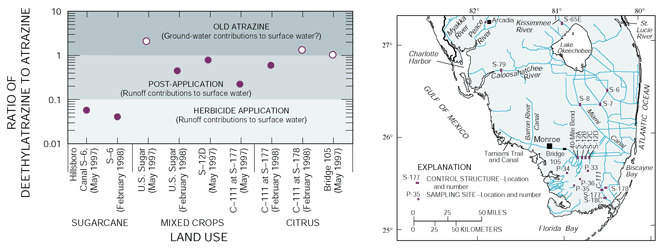 |
| Figure 10. Ratio of deethylatrazine to atrazine (DAR) in surface water at selected sites, 1997–98 (M.T. Meyer, U.S. Geological Survey, written commun., 1998). |
| Table of Contents || Previous Section || Next Section || Glossary U.S. Geological Survey Circular 1207 Suggested citation:
|


